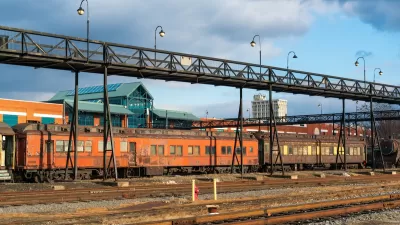Changes to boarding platforms and a switch to electric trains could improve U.S. passenger rail service without the added cost of high-speed rail.

A new report by the NYU Marron Institute’s Transit Costs Project by researcher Nolan Hicks suggests a “suite of targeted improvements” dubbed the “momentum” framework that could speed up passenger rail service in the United States by up to 30 percent — without high-speed rail.
As Benjamin Schneider explains in Bloomberg CityLab, “Hicks’ Momentum approach achieves its time savings not so much from increasing top speeds, but from reducing the “dead time” trains spend idling at stops and getting back up to speed again.” According to Hicks, U.S. trains spend a lot of time at stops due to low boarding platforms that extend boarding time for passengers and diesel locomotives that take longer to start up and get up to speed.
“The first intervention Hicks recommends is high-level boarding platforms. This ADA-accessible design allows passengers to walk or roll aboard without alighting any stairs. It also enables a train car design with wider doors, so more people can get on and off more quickly.” More importantly, electrified trains would accelerate at twice the rate of diesel locomotives, letting trains travel at maximum speed for more of the trip.
“In effect, Hicks is calling for a national rail network built up to the standards of the Northeast Corridor — not a world-class high-speed rail line, but a popular, profitable route that dominates the travel market in its region.” These upgrades could be more attainable for U.S. rail markets, but obstacles such as shared tracks with freight lines and NIMBY resistance to electrical wires and infrastructure remain.
FULL STORY: The Secret Formula for Faster Trains

Alabama: Trump Terminates Settlements for Black Communities Harmed By Raw Sewage
Trump deemed the landmark civil rights agreement “illegal DEI and environmental justice policy.”

Study: Maui’s Plan to Convert Vacation Rentals to Long-Term Housing Could Cause Nearly $1 Billion Economic Loss
The plan would reduce visitor accommodation by 25% resulting in 1,900 jobs lost.

Planetizen Federal Action Tracker
A weekly monitor of how Trump’s orders and actions are impacting planners and planning in America.

This Toronto Suburb Has More Bus Riders Than Columbus, Ohio
Brampton, Ontario used gradual improvements in service to prove that if you build it, they will ride.

Paris Bike Boom Leads to Steep Drop in Air Pollution
The French city’s air quality has improved dramatically in the past 20 years, coinciding with a growth in cycling.

Why Housing Costs More to Build in California Than in Texas
Hard costs like labor and materials combined with ‘soft’ costs such as permitting make building in the San Francisco Bay Area almost three times as costly as in Texas cities.
Urban Design for Planners 1: Software Tools
This six-course series explores essential urban design concepts using open source software and equips planners with the tools they need to participate fully in the urban design process.
Planning for Universal Design
Learn the tools for implementing Universal Design in planning regulations.
Smith Gee Studio
Alamo Area Metropolitan Planning Organization
City of Santa Clarita
Institute for Housing and Urban Development Studies (IHS)
City of Grandview
Harvard GSD Executive Education
Toledo-Lucas County Plan Commissions
Salt Lake City
NYU Wagner Graduate School of Public Service





























